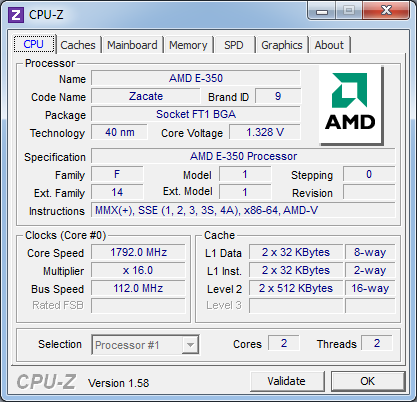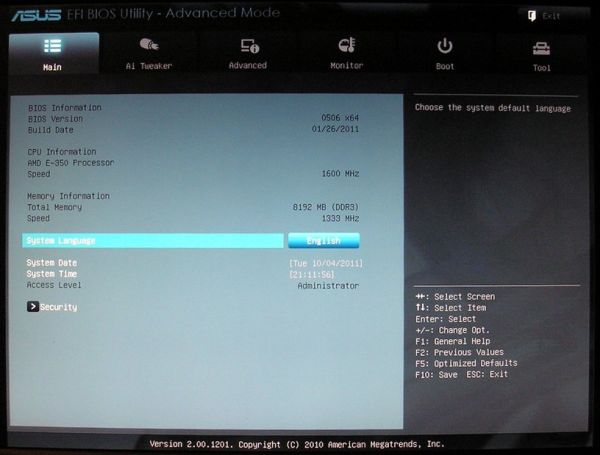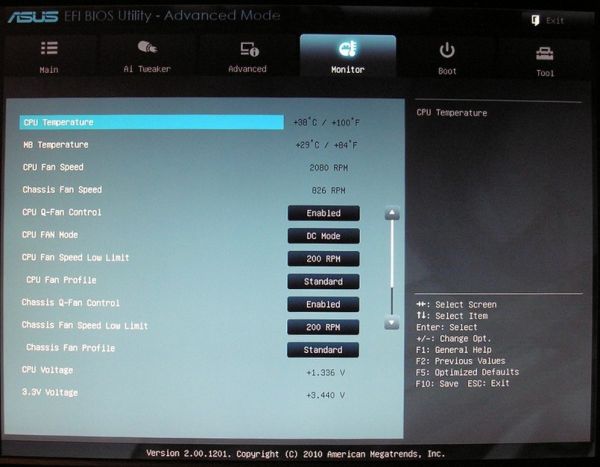ASUS E35M1-M Pro Review - Anyone For Fusion?
by Brendan van Varik on October 25, 2011 5:00 AM EST- Posted in
- Asus
- Motherboards
- Fusion
- E-350
BIOS
When you first enter BIOS, you will notice that ASUS have used a graphical BIOS with this motherboard. The BIOS itself is very easy to navigate through and when you get into it for the first time, you are faced with the ‘EZ Mode’ which shows you the basic things which a user may use or need to change such as the boot order of the system. When you enter the ‘Advanced Mode’, it opens up the entire BIOS so that you can turn things on or off which you would not find in the basic setup.
It is nice to see that overclocking features have been included in this BIOS but I do not think that many users will be buying this motherboard with overclocking in mind, as that will only raise power consumption and temperatures.
The fan controls in the BIOS allow you control both fan headers on the motherboard. You have a few options available which allow for either optimized cooling based on temperature, or if a quiet computing experience is preferred, that option is at your disposal too.
There are no noticeable changes between the release BIOS and the latest BIOS which is available on the ASUS website. ASUS claim improved system stability is achieved with the latest release although I have not experienced any issues on the shipped BIOS.
Overclocking
While overclocking may not be a strong point of this motherboard, it is still possible to squeeze a bit of extra performance out of the APU. I started with the ASUS Suite II software to see how good the automated overclocking was. The auto-overclocking feature added 3 MHz to the bus speed which increased the overall CPU speed by 48 MHz to give a final clock speed of 1648 MHz. The same overclock is applied if you select the AutoTune feature within the BIOS. It was stable but the increase in performance was not that noticeable.
Going through the BIOS, I was able to achieve a better result. The APU has a stock clock speed of 1.6 GHz and I was able to push it up to 1.792 GHz by using a 112 MHz base clock. All voltages were left on auto. When I went any higher than 112 MHz on the base clock, the motherboard would occasionally have an issue getting into Windows. However, from a stability standpoint, everything worked flawlessly at 112 MHz.

Along with standard stability tests, for completeness, the system was put under a 100 per cent loading for ten minutes and then the PC was put into a sleep state for the night. It switched on in the morning without any issues and full usability. When a 112 MHz base clock was used, there were no issues and the system was fully usable.


















66 Comments
View All Comments
Aries1470 - Thursday, October 27, 2011 - link
p.s. I Forgot to mention that although it is capable of blue-ray etc it is only a DX9 that they have paired it with. They did not use the other options that S3 provide for at least a DX10.1silverblue - Thursday, October 27, 2011 - link
Nano X2 is a very promising technology, but reviews (and comparisons) have been somewhat lacking thus far. Unlike the 65nm single core variants, these are 40nm, and from looking at them in comparison to the E-350 and Zacate, they're the fastest, if only slightly ahead of the AMD part. It would be good to see VIA and AMD do well in this market.There was a look here in the Brazos review:
http://www.anandtech.com/show/4134/the-brazos-revi...
There's a video here of the 4350's power consumption and video playback:
http://www.youtube.com/watch?v=5FI4ctKzGnQ
Here's one of the 4650 quad core variant:
http://www.youtube.com/watch?v=EXeROMRmqTA&fea...
Aries1470 - Sunday, October 30, 2011 - link
Hi silverblue,Just wanted to say thank you for the links. Would have been great in the brazos review if they also had the power consumption, not just how powerful it is ;-)
Great youtube links too.
Just didn't know that the Nano X2 was better than the Brazos. You hear all about AMD but nearly nothing about VIA.
UrQuan3 - Wednesday, November 9, 2011 - link
After Via sold S3 (their graphics group) I have heard very little from them. They had a good looking chipset in the works, but we probably won't see it now. I'm actually tempted to ask for one of the engineering samples like the one Anand reviewed.Finraziel - Monday, October 31, 2011 - link
Used this board's little mini-itx brother, the E35M1-I, in a build for my mom a while ago... Built into a mini-itx case with laptop power supply, a 500 GB WD Blue drive and a slimline DVD burner, along with one 120mm scythe fan (the slim version so it would fit), and it only used just over 20 watts in idle... Of course, it's not quite the same board, but I'm still guessing that 250 watt PSU is still pretty inefficient.My mom's completely happy with this system btw, she browses the web, plays some casual games, some minimal office work, and for that kind of usage this system offers plenty of power. Also with the 20-25 watt power draw, it doesn't matter that she never turns her PC off.
Harry Lloyd - Monday, October 31, 2011 - link
How come this board has eSATA, and NOT ONE FM1 board does?